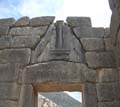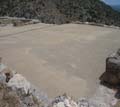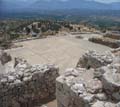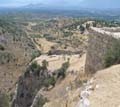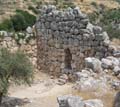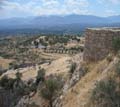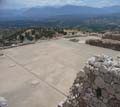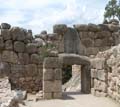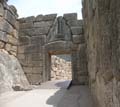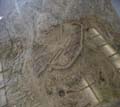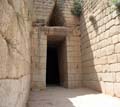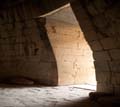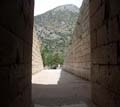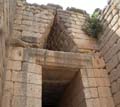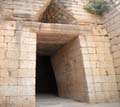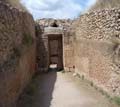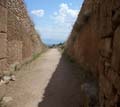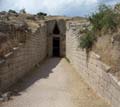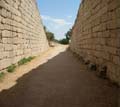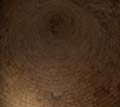
The acropolis of Mycenae, built in a naturally fortified position, in the northeastern part of the Argolic plain, is one of the few cities of Greek prehistory that was never forgotten. According to mythology, Mycenae was founded by Perseus, son of Zeus and Danae, who led the first royal dynasty of Mycenae. The Pelopidas dynasty followed, with Atreus as the first ruler, whose son and successor was Agamemnon, the "king of men" who led all the Greeks in the war against Troy. The tragic fate that the gods reserved for the generation of Atreides inspired the great ancient Greek poets, while the echo of the Mycenaean era of heroes and kings continues to this day to be a source of inspiration and creation for all forms of art.
Mycenae has been inhabited since the Neolithic and Proto-Helladic periods (3000-2000 BC), as the few but indicative findings testify. In the Middle Helladic era (2000-1600 BC) an extensive cemetery was established on the western side of the hill which includes Burial Circles A and B with the royal tombs as well as numerous pit and box-shaped tombs. Mycenae reached the height of their prosperity during the Late Helladic Era (1600-1100 BC) and gave their name to Europe's first brilliant civilization.
About a hundred years after the fall of Troy, political and economic decline brought the city of Mycenae withering, which continued to exist as a settlement in the Geometric and Archaic years until it was captured and destroyed by the Argives in 467 BC. The last glimpse of Mycenae dates back to Hellenistic times (3rd century BC-1st century AD), when a new wall was built in the lower city, a theater, a temple, an aqueduct and laboratory facilities inside and outside the acropolis . Unfortunately, however, few remains were preserved until the time when Strabo first, and Pausanias much later visited Mycenae to get to know the place where the brilliant Mycenaean civilization flourished.
The interest in Mycenae revived again in the 17th and 18th centuries when travelers from all over Europe rushed to browse the remnants of Greek history and record the treasures and monuments of Greece. The excavations carried out in 1876 by H. Schliemann at the site, bringing to light the royal tombs of Cycle A, with the masterpiece art objects, opened the chapter of the modern history of Mycenae and paved the way for the systematic excavation research at the site from Archaeological Society, the British School of Archeology and the Archaeological Survey, which continues to this day.
What impresses the visitor at first sight today are the cyclopean walls which surround the acropolis almost on its entire perimeter and for the construction of which, according to tradition, the mythical Cyclops were recruited. These monumental works that exceed 13m in height. and 8m wide, were built in three successive phases from the middle of the 14th century until 1230 BC. about.
The main entrance to the acropolis is the famous Lion Gate, built in 1250 BC. about. The famous relief of lions that decorates the triangle above the gate's ridge is the oldest example of monumental sculpture in Europe.
The second gate of the citadel is located in its northern part.
On the western slope of the hill of the acropolis is Burial Circle A, the cemetery of the first rulers of Mycenae, dating from the middle of the 16th century BC. Six vertical pit-shaped royal tombs were found here with a total of 19 burials accompanied by unique and valuable finds, most of which are currently on display in the National Archaeological Museum of Athens.
The slope of the hill that extends south of Burial Circle A is occupied by building complexes of the 13th and 12th centuries BC, the most important of which are the so-called Religious Center, with the residences of the priests and places of worship, where the most important frescoes were found of Mycenae and the unique idols of human figures and snakes.
At the top of the citadel, dominates the residence of the anakta and the royal family.
Monuments representative of prehistoric and historical times are scattered in a radius of 1 kilometer around the perimeter of the acropolis. These are burial complexes, residential complexes, workshops, roads, bridges and quarries from the Mycenaean era, but also sanctuaries from the Archaic and Hellenistic times, which bear witness to the continuous habitation of the wider area from prehistoric times to Hellenistic times.
Among the most important monuments outside the acropolis is the Burial Circle B which is located west of the walled settlement. It contains 25 tombs, most of which belong to the type of vertical pit tombs, a type characteristic of early Mycenaean burial architecture.
The vaulted tomb of Atreus is undoubtedly the most brilliant and best-preserved example of a vaulted tomb found at Mycenae. It is dated between 1350-1250 BC.
The multitude of monuments and finds rank Mycenae as one of the most important treasures of our cultural heritage and are the most important testimony to the achievements of a civilization that was built on a strictly bureaucratic system of control and management of the economy and social organization, setting the bases for the creation of the city-states that developed in the Greek area during historical times.
Even today, the acropolis of Mycenae dominates the Argolic plain projecting the surviving cyclopean walls as eternal witnesses of its glorious past. The capital of Agamemnon and Clytemnestra, the homeland of Orestes and Iphigenia, Mycenae, unveils the veil of myth to thousands of visitors every day and takes them on a journey to the beginnings of Greek civilization.
Editor: Fotini Anastasopoulou










